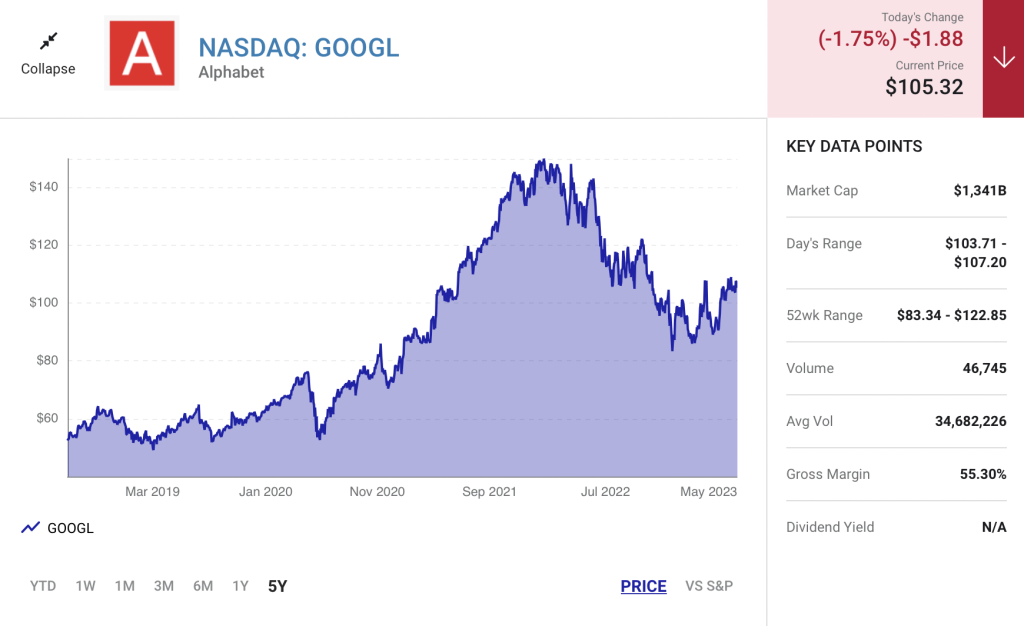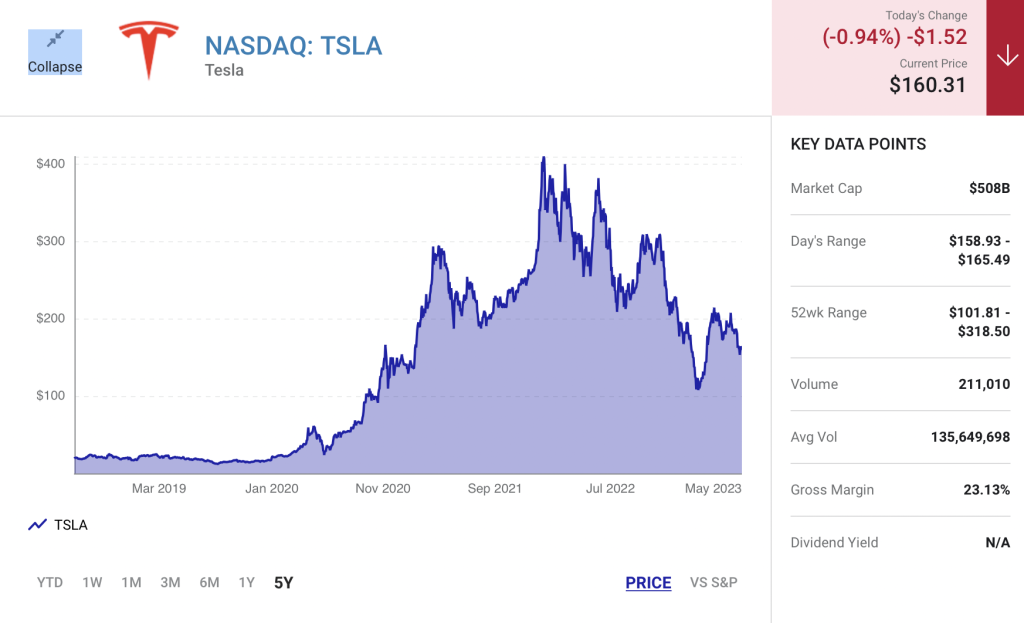A half-dozen, high-profile companies split their stock last year. One stands out as an exceptional value in May, while another is seeing its competitive advantages erode.
Volatility is the price of admission to one of the greatest wealth creators on the planet. In 2022, investors were given a hearty serving of uncertainty and volatility, with all three major U.S. stock indexes plunging into a bear market and, ultimately, delivering their worst full-year performances in more than a decade.
But the interesting thing about investors is their resilience. No matter how bleak things may appear in the short term, investors always find a way to latch onto outperformers. Over the past year, stock-split stocks have been the companies they’ve flocked to.
A stock split is an event that allows a publicly traded company to alter its outstanding share count and share price without impacting its market cap or any aspect of its operations. It’s a purely cosmetic move that can lower a company’s share price to make it more easily tradable for everyday investors who don’t have access to fractional-share purchases. A stock split can also increase a company’s share price to ensure it remains listed on a major exchange. The latter move is known as a reverse stock split, while the former is a forward stock split.
Most investors tend to focus on forward stock splits because they’re conducted by companies with rising valuations that are almost always out-innovating and out-executing their competition. Last year, a half-dozen prominent stocks enacted forward splits, including Amazon (AMZN 1.55%), Alphabet(GOOGL -1.75%) (GOOG -1.61%), Tesla (TSLA -0.94%), Shopify (SHOP -1.06%), Palo Alto Networks(PANW -3.50%), and DexCom (DXCM -0.27%).
But among these top-tier stock-split stocks, there are clear standouts in May. One of these companies is historically inexpensive and ripe for the picking, while another is seeing its competitive advantages erode before our eyes.
The stock-split stock that’s a surefire buy in May: Alphabet
Among the high-profile companies to have split their stock over the past year, the one that stands out as a phenomenal buy in May is Alphabet, the parent company of popular internet search engine Google, autonomous vehicle company Waymo, and streaming platform YouTube. Alphabet enacted a 20-for-1 forward split in mid-July.
Keeping in mind that even the best stocks face challenges and headwinds, Alphabet’s biggest concern at the moment has to be the growing likelihood that the U.S. economy will fall into a recession. A number of indicators have been sounding warnings for months that an economic downturn is likely. Furthermore, the minutes from the Federal Open Market Committee’s March meeting officially forecast a “mild recession” for later this year.

Although the stock market and U.S. economy don’t move in tandem, losses for equities tend to be more pronounced, historically, after a recession is declared. Alphabet generates the bulk of its revenue from advertising. Businesses aren’t shy about paring back their ad budgets at the first sign of a possible recession. In other words, Alphabet could certainly endure some weaker growth prospects in the coming quarters, especially if U.S. economic growth shifts into reverse.
But as I’ve previously pointed out, this is a two-sided coin that very much favors the patient investor. Even though recessions are inevitable, every recession after World War II has lasted just two-to-18 months. That compares to periods of expansion, which are typically measured in years. Ad-driven businesses enjoy strong pricing power a disproportionate amount of time.
Alphabet’s bread-and-butter operating segment continues to be its internet search engine. In March, Google accounted for 93.2% of global internet search share, according to data from GlobalStats. You have to go back to March 2015 to find the last time Google accounted for less than 90% of worldwide search. As long as Google has a roughly 90-percentage-point advantage over its next-closest competitor, it’s going to maintain exceptional ad-pricing power.
Yet what’s really exciting is what Alphabet is doing with the cash flow it’s generating from Google. One of its faster-growing initiatives is Google Cloud. Enterprise cloud-infrastructure spending is still, arguably, in its infancy, and Google Cloud has managed to gobble up 10% of global cloud infrastructure-service spending as of the fourth quarter of 2022, per Canalys.
More importantly, Google Cloud generated a profit for Alphabet in Q1 2023, which reversed a sizable loss from the prior-year period. Cloud services generally offer much juicier margins than advertising. Looking years down the line, Google Cloud has an opportunity to become a core cash-flow driver for Alphabet.
Lastly, don’t overlook Alphabet’s historically cheap valuation. Investors have the opportunity to purchase shares of Alphabet right now for just 17 times Wall Street’s consensus earnings in 2024. Likewise, after averaging a price-to-cash-flow multiple of 18.4 over the past five years, it can be purchased for less than 12 times estimated cash flow for the upcoming year. Alphabet stock is ripe for the picking in May.
The stock-split stock investors should avoid in May: Tesla
However, not all stock-split stocks offer attractive outlooks at the moment. With a potential recession on the horizon and competition rapidly picking up, electric vehicle (EV) manufacturer Tesla is the stock-split stock to avoid in May. Tesla completed a 3-for-1 split in late August.
Just as top-tier stocks have headwinds, companies to avoid have their potential catalysts. Tesla didn’t get to where it is by accident. It did so by building its operations from the ground up. With four gigafactories, Tesla can mass produce in the neighborhood of 2 million EVs annually. In 2023, the company is targeting 1.8 million EVs, which would be a nice uptick from the 1.37 million EVs produced last year.
Tesla has also delivered in the profit column. Whereas the EV divisions of virtually all new and legacy automakers are deeply in the red, Tesla has generated a generally accepted accounting principles (GAAP)profit in each of the past three years. This streak will likely continue in 2023.
Unfortunately, many of the competitive advantages that Tesla has enjoyed are beginning to wane as new competition enters the picture. The easiest way to tell this is happening is by taking a closer look at Tesla’s pricing activity. The company has reduced prices on its core EV models six separate times in 2023. While Tesla optimists claim this has to do with operating efficiencies reducing the price of its EVs, the company’s rapidly rising inventory tells another story. Its vehicle inventory at the end of March 2023 stood at 15 days, which represents the highest mark since Q3 2020.

Without accounting for all of these price reductions (some of which have taken place since the end of Q1), as well as excluding the benefit of $521 million in renewable energy credits (RECs), Tesla’s automotive gross margin slipped to 18.3% during Q1. Whereas Wall Street was expecting $3.2 billion in free-cash flow from Tesla, the company reported an $80 million free-cash outflow, if we exclude RECs.
Another problem for Tesla is that it’s been unable to transform itself into more than just a car company. Yes, it has a supercharger network, offers solar panel installation, and operates an energy storage business. However, these are generally low-margin operations that lose money once below-the-line expenses are factored in. Tesla’s entire GAAP profit depends on selling and leasing EVs.
The reason this is noteworthy is because auto stocks traditionally trade at a multiple of 6 to 8 times earnings, with a little bit of an exception for automakers with faster growth prospects. Tesla is commanding a price-to-earnings multiple closer to 50 in 2023. That’s not a multiple that makes sense for a highly cyclical industry when a potential recession is on the horizon.
But the biggest issue of all for Tesla might be its CEO, Elon Musk. Musk is a visionary, but he’s also a huge liability in a variety of ways. He’s constantly drawing the attention of securities regulators for all the wrong reasons, and the vast majority of his innovations/promises end up delayed or scrapped. It’s quite possible Tesla’s share price deflates as more of Musk’s innovations fail to come to fruition. For that and the many other reasons listed above, Tesla is an easy avoid in May.
Read next – Secret NASA project will destroy Elon Musk
Between 1956 and 1958, NASA and the United States Air Force conducted a series of covert tests in an isolated compound in rural Virginia.
Access to this special program was classified higher than “Top Secret”…
And only 25 people knew of the project’s existence.
Its codename was Project Suntan.
Its mission?
To develop an entirely new type of fuel that would allow the U.S. to achieve total energy dominance over the Soviet Union.
The elite team of physicists and engineers were given a blank check by the government and told to do “whatever it takes.”
After two years and $2 billion…
The members of Project Suntan stumbled on a MASSIVE discovery.
A way to convert one of the Earth’s most abundant resources into cheap, powerful, virtually endless energy.
Following their discovery, the team was quietly disbanded.
And this new fuel was kept secret by the highest levels of U.S. intelligence.
But all that is changing as we speak.
Finally, after more than 60 years in secrecy, this fuel is slowly being rolled out to the public.
And one tiny company has obtained the patents on this world-changing “Future Fuel.”
Forget Tesla, or any of the other “alternative energy” companies out there.
Once this “Future Fuel” hits mainstream, it will make electric power obsolete.
It will make wind and solar obsolete.
It will even make oil obsolete.
And it will hand investors a once-in-a-lifetime chance to get rich.
Imagine if you had been able to invest in the birth of the oil economy.
You would have had more wealth than you could ever imagine.
Well, you have a rare second chance.
Because as “Future Fuel” replaces oil, wind, solar, and electric…
Investors could turn every $500 into $234,000 or more.
The future is here.





